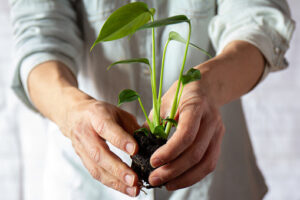Table of Contents

Introduction
Plants have primarily two types of tissues that help transport water, minerals, and nutrients. Those tissues are – the xylem and phloem.
Trees play an important role in the transportation of nutrients and water to plants.
Water is a limiting factor in the growth of plants. Trees can use their natural transportation system to overcome this issue.
Plants have a massive network of pipes known as phloem and xylem. These organs regulate the movement of blood and nutrients throughout the plant. The xylem and phloem tissues move up through the tree’s trunk and into the branches.
Plants transport substances at three levels:
- Substances are transported from one cell to another.
- Xylem and phloem transport sap over long distances.
- Each cell releases and absorbs solutes and water in its own way.
Let’s examine the process of absorption and transportation in plants in more detail.
Plant Transport
Water and minerals are transported in plants by two types of conducting tissues:
- Xylem
- Phloem
Xylem
The xylem is a long, non-living tube running from the roots to the leaves through the stem. By osmosis, the water moves from cell to cell in the root hair until it reaches the xylem. Water is then transported through the xylem vessels to the leaves where it is evaporated by transpiration.
The xylem is also composed of elongated cells like the phloem. Water is transported from roots to all plant parts via xylem. Since they serve such an important function, a single tree would have a lot of xylem tissues.
Phloem
The phloem is responsible for transporting nutrients such as sugar and carbohydrates that are produced by the leaves to areas of the plant that are metabolically active. It is made up of living cells. The walls of these cells form small holes at the ends of the cells known as sieve plates.
Active Transportation
Active transport materials pump molecules against concentration gradients. Here the ATP energy is used to drive the pump. ATP delivers phosphate to a particular gateway molecule and then pumps the required molecule across the membrane.
Driving Forces for Plant Transport
The driving force responsible for transporting water and minerals to plants includes:
Transpiration
- The strength of the earth’s crust
- The potential gradient of water
- The ability to bind hydrogen between water molecules
- Transpiration
- Transpiration is the force that drives the capture and transport of water. It is a process of evaporation of water through holes called stomata. This creates a drain by replacing evaporated water. This pulling of the xylem tissue extends due to the combined force. This negative water pressure occurring at the roots will eventually result in an increase in groundwater runoff.
Force of Surface Tension
As more molecules evaporate in the water film, there is an increase in meniscus flexion which in turn increases the tension. Water from surrounding cells is pumped into the area to reduce the tension.
Gradient Water Power
Water from the roots to the leaves due to potential water tilt. The strong water gradient is the highest in the water around the roots and the lowest in the air space inside the sponge parenchyma.
The Power of Hydrogen Bonding between Water Molecules
Water molecules attach to one another with hydrogen bonds. The above energy is transferred to the water molecules inside the xylem by hydrogen bonds.
Plants and animals, both of which are living organisms, have a system of structures that transport various organisms throughout their body. Such an arrangement primarily serves as a transport system that facilitates the flow of water, minerals, nutrients, etc. which is essential for the survival of that organism. Plants mainly have two types of tissues that help transport water, minerals, and nutrients. Those tissues are the xylem and phloem.
Also read: Transport in Plants
FAQs
1. What do you mean by transplantation?
Ans: Transplantation refers to the movement of water and minerals from the roots to different parts of plants. Includes the flow of food prepared for the leaves to the entire plant.
2. How is food distributed to plants?
Ans: Food is delivered through phloem to plants. In the transport process, energy from ATP is used to create osmotic pressure that helps move food from high concentration to low concentration.
3. How is water transported to plants?
Ans: Water is transported to plants with the help of processed tissues and individual cells of the vascular system. Water travels near a strong water gradient and penetrates into the hair follicles and xylem through apoplast or symplast methods. This is how water is transported from the roots to the stem and other parts of the plant.
4. What are the different ways of moving plants?
Ans: The different ways of moving plants are:
- Easy distribution
- Simplified distribution
- Osmosis
- Functional transport
5. How are gases transported from plants?
Ans: Plants receive gases through leaves. The opening and closing of the cells the guards are responsible for gas exchange. Plants need carbon dioxide for photosynthesis. The gases spread through the joint areas of the leaves through the cavities of the stomach.







